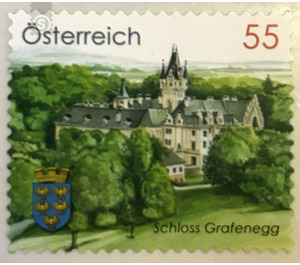Attractions - Austria / II. Republic of Austria 2010 - 55 Euro Cent
Theme: Architecture
| Country | Austria / II. Republic of Austria |
| Issue Date | 2010 |
| Face Value | 55.00 |
| Edition Issued | 5,749,000 |
| Printing Type | offset |
| Stamp Type | Commemorative |
| Item Type | Stamp |
| Chronological Issue Number | 2219 |
| Chronological Chapter | OOS-OE2 |
| SID | 344158 |
| In 49 Wishlists | |
The Lower Austrian Grafenegg Palace, located to the east of Krems, is one of the most important buildings of the romantic historicism in Austria. History: First mentioned in 1294, around 1435 the former farmyard was surrounded by a ring wall and a moat. At that time already a princely fief, it later came into the possession of the namesake Ulrich von Grafeneck, 1477 to Emperor Frederick III. At the beginning of the 16th century, it was completely rebuilt; The slender tower on the east side, whose portal is already committed to the Renaissance, dates back to this late Gothic period. After several changes of ownership, the estate was rebuilt between 1622 and 1633 to a fortified castle. At the four corners of the complex surrounded by walls and a moat, so-called wall houses were built, which still exist today. Under Count August Ferdinand Breuner-Enckevoirt and his son, the palace was completely redesigned in the second half of the 19th century in the spirit of romantic historicism by Leopold Ernst, who in 1858 was appointed cathedral master of St. Stephen in Vienna Shape. Between 1945 and 1955, the Russian occupying forces damaged the building and its furniture, parts of the book inventory were stolen or even burned. From 1967, the castle was supported by the state and the federal government and by the commitment of the former Rentmeister, Dr. Ing. Gerhard Großberger, restored and made accessible to the public. It is noteworthy, however, that although the former conversion generally dealt with the existing building material in a gentle manner, the addition of stepped gables, arcades and decorations on the façade in the neo-Gothic Tudor style gave the palace a completely different overall impression, which continues until the interior decoration. Grafenegg Castle, together with its outbuildings, is surrounded by a 30-hectare park with numerous sculptures and more than 2,000 partly exotic deciduous and coniferous trees and more than 250-year-old giant trees. For the Landesgartenschau 2008, the park was revitalized, based on the design principles of a landscape garden in the 19th century. Today, the castle is a popular excursion and event location, which is considered a fixture of Austria's cultural landscape; Above all, the "Grafenegger Advent", to be admired every year, is a veritable crowd puller. In addition, since 2007, the so-called "Music Festival Grafenegg" under the artistic direction of the well-known pianist Rudolf Buchbinder instead.


